식품 알레르기(음식물 알레르기 /음식물 알러지/음식 알레르기) Food allergy
식품 (음식물)으로 다음 문제가 생길 수 있다
① 식품 유해 작용(Food adverse reaction)이 유발될 수 있고
② 식품 과민작용(식품 알레르기 반응/Food hypersensitivity)이 유발될 수 있고
③ 식품 아나필락시스(Food anaphylaxis)이 유발될 수 있고
④ 식품 불내증(Food intolerance)이 유발될 수 있다.

사진 132. 소아청소년 (0~18세)들에게 식품 알레르기를 가장 흔히 유발시킬 수 있는 식품
달걀, 우유, 땅콩, 메주콩, 밀 음식물, 나무 견과(호두, 피칸, 피스타치오, 브라질 호두 등), 패류, 생선 등으로 식품 알레르기가 가장 잘 유발될 수 있다. 아이들에게 생기는 식품 알레르기의 95%는 달걀, 우유, 땅콩, 또는 메주콩 등으로 유발된다고 한다.
Copyright ⓒ 2011 John Sangwon Lee, MD., FAAP
식품 알레르기(음식물 알레르기)의 개요와 발병률
- 식품으로 유발된 알레르기를 식품 알레르기(Food allergy), 음식물 알레르기, 음식 알레르기, 식품 알레르기 질환, 음식물 알레르기, 식물 알러지, 식품 알러지 또는 소화관 알러지라고 한다.
- IgE 중개 식품 알레르기는 미국 아이들이나 영국의 아이들의 6~8%, 성인들의 2%에게 생긴다(출처; The New England Journal of Medicine, Sep.18, 2008).
- IgE 중개 식품 알레르기가 성인들에게 25%정도 유발될 수 있다는 연구도 있지만 실제로는 3%이하 생긴다.
- 미국에서는 식품 알레르기로 연간 30,000여명이 응급치료를 받고 거의 2,000명이 사망한다.
- 어린 영유아들에게 생긴 식품 알레르기의 대부분은 점차로 성장하면서 자연히 없어지기도 하지만 영유아들에게 생긴 땅콩, 호두, 피칸, 피스타치오, 브라질 호두 등 나무 견과류 식품알레르기, 어패류, 해산물 식품 알레르기는 완전히 없어지지 않고 일생동안 지속 될 수 있다.
- 동물성 음식물이나 식물성 음식물에 있는 글라이코프로테인(단 단백질) 성분으로 식품 알레르기가 유발될 수 있다.
- 달걀, 우유, 땅콩, 나무 견과류, 참깨 등 음식물이 영유아들에게 식품 알레르기를 가장 흔히 일으킬 수 있다.
- 최근에는 키위(Kiwi) 알레르기가 증가 추세이다.
- 밀가루 음식물이나 메주콩 음식물로 식품 알레르기가 유발될 수 있지만 임상적으로 확실히 진단하기가 어렵다.
- 소아청소년 식품 알레르기의 95%는 달걀, 우유, 땅콩과 메주콩 이 4가지 음식물로 주로 생긴다고 한다, 참조문헌-③.
- 성인들은 조개류 해산물, 생선, 땅콩, 나무 견과류의 음식물로 인해 식품 알레르기가 가장 흔히 유발될 수 있다.
- 식품 알레르기의 발생률은 사는 나라에 따라 지역에 따라 다르다. 예를 들어 불란서에는 머스타드 식품 알레르기가 많고, 이스라엘에서는 참깨 알레르기가 많이 발생되고, 나라, 지역이나 지방의 차이 없이 달걀 음식물 알레르기, 우유, 우유음식물 알레르기는 발생한다(출처; Food allergy, The New England Journal of Medicine, Sept. 18, 2008).
- 달걀 음식물 알레르기는 소아 청소년들의 1.5~3.2%에서 생긴다. 달걀 음식물로 생긴 알레르기의 66%는 5세가 될 때까지 없어질 수 있고, 7세가 될 때까지 75%는 없어진다고 한다. 달걀 음식물 알레르기가 생후 16세까지 없어지지 않으면 일생동안 계속된다고 한다.
- 식품 알레르기는 아토피 체질이 있는 아이들에게 아토피 체질이 없는 아이들 보다 더 잘 발생된다.
- 아토피 체질이 있는 아이들에게 음식물로 인해 알레르기 질환이 생길 가능성이 더 많으므로 어떤 종류 음식물도 식품 알레르기를 일으킬 수 있다고 가정하고 음식물을 가려 먹여야한다.
- 식품 알레르기가 아닌 다른 어떤 병으로 생긴 증상 징후가 식품 알레르기로 생긴 증상 징후와 비슷할 수 있다. 그래서 다른 어떤 병으로 생긴 증상 징후를 식품 알레르기의 증상이나 징후로 잘못 판단되는 경우도 많다.
- 예를 들면, 유당 불내증, 식중독, 위장관 감염병, 정신 신경질환 등으로 생긴 증상 징후나 징후가 식품 알레르기로 생긴 증상이나 징후와 거의 비슷할 수 있다. 그 때문에 유당 불내증이나 식중독, 또는 감염병 등을 식품 알레르기로 오진할 수 있다.
- 때로는 식품 알레르기로 생긴 증상 징후와 똑 같은 증상 징후가 식품 알레르기가 아닌 다른 병으로도 유발될 수 있다.
- 예를 들면, 유당 불내증으로 복통과 우유 단백 알레르기로 생긴 복통과 거의 비슷할 수 있다. 이런 이유로, 식품 알레르기로 생긴 증상 징후와 다른 병으로 생긴 증상 징후를 감별 진단해야 한다.[부모도 반의사가 되어야한다-소아가정간호백과]-제5권 인공영양, 이유식, 비타민, 미네랄, 지방, 단백질-아기가 우유로 만든 인공영양을 먹을 수 없는 경우,
- 제12권 소아 신경, 정신, 정서, 행동, 심리, 수면문제-단순 틱증 참조
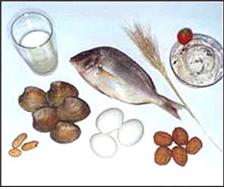
사진 133. 우유, 달걀, 땅콩, 견과류, 생선, 밀가루 등 음식물은 식품 알레르기를 더 잘 유발시킬 수 있다.
Copyright ⓒ 2011 John Sangwon Lee, MD., FAAP
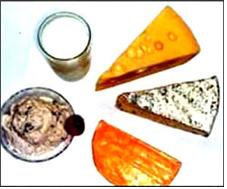
사진 134. 우유나 우유로 만든 음식물로 식품 알레르기가 더 잘 유발될 수 있다.
Copyright ⓒ 2011 John Sangwon Lee, MD., FAAP
식품 알레르기(음식물 알레르기)의 원인
1. 면역 글로불인 E(IgE) 매개로 생긴 식품 알레르기
- 면역글로불린 E(IgE) 매개로 생긴 식품 알레르기의 1차적 표적 기관들은 구강과 인두 등 소화기계이고 2차적 표적 기관들은 피부, 폐, 혈관 등이다.
1) 구강 알레르기 증후군(Oral allergy syndrome)-입술, 구강, 인두가 붓고 가려운 증상이 생길 수 있다.
2) 위장 아나필락시스(Gastrointestinal anaphylaxis)-구기, 구토, 상복부 복통, 복부팽만, 방구, 설사 등의 위장 장애 증상이 생길 수 있다.
3) 급성 두드러기, 혈관 부종(Acute urticaria and angioedema), 아토피성 피부염이 피부에 유발될 수 있다. 기관지 천식 및, 또는 알레르기 비염 이 유발될 수 있고,
4) 아나필락시스(Anaphylaxis)- 숨이 가쁘고, 청색증이 생기고, 저혈압, 쇼크 등 증상 징후가 생길 수 있다.
2. 면역 글로불인 E(IgE)와 비 면역 글로불인 E(IgE)매개로 생긴 혼합형 식품 알레르기
1) 아토피 피부염 Atopic dermatitis
- 부모도 반의사가 되어야한다-소아가정간호백과-제17권 소아청소년 피부질환-아토피성 피부염 참조
2) 알레르기성 호산성(호산구성) 식도염 Allergic eosinophilic esophagitis
- 부모도 반의사가 되어야한다-소아가정간호백과-제9권 소아청소년 소화기계 질환-호산성 식도염 참조
3) 알레르기성 호산성 위장염 Allergic eosinophilic gastroenteritis
- 구기, 구토, 설사, 심한 상복부 복통 등의 증상이 유발될 수 있다.
- 혈 중 호산구 수가 증가되고 위장관 벽에도 호산구가 증가된다.
- 알레르기를 일으킨 식품에 대한 피부검사가 양성으로 나타나며 그 식품을 먹으면 증상이 심해진다.
3. 비 면역 글로불인 E(IgE)매개로 생긴 식품 알레르기
1) 음식 단백 유발 항문대장염(Food protein-induced proctocolitis)
2) 음식 단백 유발 소장결장염(Food protein-induced enterocolitis)
출처; Pediatric annals, vol 37, November 8, 2008.
식품 알레르기를 구체적으로 더 설명하면
- 화분으로 생기는 알레르기 비염은 IgE 매개로 생기고, 구강 내 소양증이나, 구강 내에 얼얼한 증상이 생기는 구강 내 식품 알레르기의 대개가 IgE 매개에 의해서 생긴다.
- IgE 매개에 의해서 생기는 식품 알레르기는 식품을 먹은 후 불과 몇 초 내지 몇 분에 생기는 것이 보통이다.
- 늦게는 먹은 후 한두 시간 내 유발될 수 있다.
- 우유 단백 알레르기나 콩 단백 알레르기로 생기는 소장 결장염은 T-세포 매개로 생긴다. T-세포 매개로 생긴 식품 알레르기는 먹은 후 3~4시간 후에 생기는 것이 보통이다.
- 식품 알레르기는 아이들의 5~8%에게 유발될 수 있지만 식품 알레르기가 아닌 식품 유해 반응(Food adverse reaction)은 25% 정도 유발될 수 있다.
- 우유, 달걀, 땅콩, 메주콩, 밀가루, 조개, 물고기, 호두, 견과, 초콜릿 등의 식품은 다른 종류의 식품보다 식품 알레르기를 더 잘 유발시킬 수 있다.
- 쌀 단백질 알레르기로 인해 소장 결장염이 유발됐다는 연구도 있지만 일반적으로 쌀 식품은 저 알레르기성 식품이다(출처; Journal watch pediatrics and adolescent medicine vol #1).
- 경미한 우유 알레르기나 달걀 알레르기는 성장하면서 더 이상 생기지 않을 수 있으나 땅콩이나 나무 견과류 알레르기는 성장에 관계없이 일생동안 계속 생길 수 있다.
식품 알레르기(음식물 알레르기)의 증상 징후
- IgE 매개에 의해서 생기는 식품 알레르기는 식품 알레르기 반응이 신체의 한 계통의 한 기관에만 나타날 수도 있고 신체의 여러 계통의 여러 기관에 동시 나타날 수도 있고, 전신에 나타날 수도 있고 신체의 한계통의 한 국소에만 나타날 수 있다.
- IgE 매개에 의해서 생긴 식품 알레르기로 두드러기가 국소적으로 날 수 있고 아나필락스 반응도 유발될 수 있다.
달걀-달걀 증후군 Egg-egg syndrome(Occupational egg allergy)
- 달걀 단백 성분이 든 약품이나 음식물을 만드는 과정에서 미세 용량의 달걀 단백 성분이 들어 있어도 그 달걀 단백 성분으로 인해 달걀 알레르기가 유발될 수 있다.
- 이렇게 생기는 증상을 달걀-달걀 증후군이라고 한다
(참조; Food allergy, The New England Journal of Medicine, Sep.18, 2008).
신체 여러 계통의 여러 기관에 유발되는 식품 알레르기의 증상 징후는 다음 각항을 참조
- 호흡기계에 생길 때-콧물, 비염, 천식, 천명 등
- 피부계와 점막층에 생길 때-두드러기, 피부 홍조, 혈관 부종, 접촉성 두드러기, 아토피 피부염의 증상과 징후가 더 심해지는 등
- 소화기계에 생길 때-구토, 복통, 설사 등
- 중추신경계에 생길 때-음식물 기피증, 감정의 변화, 우울증 등
- 근육 골격계에 생길 때-근육 골격통, 성장통 등
- 심장 혈관계에 생길 때-가성 빈혈, 편두통
- 그 외 다른 계통이나 기관에 생길 때
식품 알레르기가 유발되기 시작하는 최초연령
- 달걀 식품 알레르기-생후 6~24개월
- 우유 식품 알레르기-생후 6~12개월
- 땅콩 식품 알레르기-생후 6~24개월
- 나무 견과류 식품 알레르기-1~17세
- 참깨 식품 알레르기-생후 6~36개월
- 생선 식품 알레르기-후기 사춘기나 성인기
- 조개류 식품 알레르기-성인기
- 밀가루 식품 알레르기-생후 6~24개월
- 메주콩 식품 알레르기-생후 6~24개월
- 키위 식품 알레르기-어느 연령
- 사과 식품 알레르기-후기 사춘기와 성인기
- 당근 식품 알레르기-후기 사춘기와 성인기
- 복숭아 식품 알레르기-후기 사춘기와 성인기
출처-Food allergy, The New England Journal of Medicine, Sep.18, 2008
식품 알레르기(음식물 알레르기)의 진단
- 병력, 증상 징후, 진찰소견 등을 종합해 식품 알레르기를 진단하는 것이 보통이다.
- 필요에 따라 혈중 IgE 항체(면역 글로불린 E 항체)의 농도를 알아보는
- 혈액검사
- 알레르기 피부 가시(극)검사
- 유발 검사
- IgE를 검사하기 위해 방사선 알러젠 흡수검사(RAST)
- 필요에 따라 피부 생체조직검사나 소대장 점막 생체조직검사
- 위장 내시경검사 등
- 위에 열거한 여러 검사 중 한 가지 또는 여러 가지로 식품 알레르기를 진단한다.
- 그 중 환아의 과거·현재의 병력, 가족 병력이 식품 알레르기를 진단하는데 가장 가치가 있다.
- 식품 알레르기를 진단할 때 식품 알레르기를 일으키는 음식물 섭취를 중단하고 난 후 식품 알레르기의 증상 징후가 없어지나 덜 한지, 또는 조금도 차도가 없는지 차도가 있는지 등을 보고 진단할 수 있다.
- 식품 알레르기를 진단하는 동시 식품 알레르기도 치료하는 셈이 된다.
- 일반적으로 IgE 항체에 관련된 식품 알레르기를 유발시킨다고 생각되는 음식물을 1~2주 동안 섭취하지 않으면 식품 알레르기의 증상 징후가 없어지는 것이 보통이다.
- 식품 알레르기로 생긴 소대장염의 대부분은 식품 알레르기를 일으켰던 음식물 섭취를 중단한 날로부터 3~6주 이후 쯤 증상 징후가 없어지는 것이 보통이다.
- 우유, 달걀, 땅콩 등 음식물로 유발된 식품 알레르기가 있는 아이들의 우유, 달걀, 땅콩 등의 식품 단백 IgE 항체의 혈중 농도가 증가되어 있는 것이 보통이다.
- 어떤 특정 식품 알레르기 피부 검사의 결과가 양성으로 나타나면 그 음식물(항원)에 대한 항체가 피검자의 체내에 있다는 것을 의미한다. 그러나 피부 검사의 결과가 양성이라고 해서 그 음식물로 인해 식품 알레르기가 꼭 나타날 수 있다고 장담할 수 없다. 다음과 같이 유발 검사 [부모도 반의사가 되어야한다-소아가정간호백과]-제9권 소아청소년 소화기 질환-우유 단백 알레르기 질환으로 생기는 설사, 유발 검사, 우유 단백질 알레르기 질환의 진단 참조를 해서 식품 알레르기를 진단할 수 있다.
식품 알레르기(음식물 알레르기)의 유발 검사
- 유발 검사는 식품 알레르기의 증상 징후가 경미하고 유발 검사로 인해 위험성이 생기지 않을 경우에만 의사의 지시에 따라 집에서도 할 수 있다. 그렇지 않으면 의사가 한다.
- 그렇지만 식품 알레르기의 증상 징후가 경미하든 심하든, 알레르기 전문의에 의해서 유발 검사를 실행하는 것이 안정성이 있고 이상적이다.
- 식품 알레르기를 유발시킨다고 의심되는 음식물을 2∼4주 동안 일절 섭취하지 않는다.
- 유발시켰다고 의심했던 음식물을 2∼4주 동안 먹지 않고 관찰하는 동안 전에 있었던 식품 알레르기의 증상 징후가 계속 생기는지, 생기지 않는지, 증상 징후의 정도가 덜 하는지 주의해서 관찰한다.
- 2∼4주 동안 관찰하는 중 식품 알레르기로 생겼던 증상 징후가 현저히 생기지 않거나, 덜 생기면, 그 음식물로 식품 알레르기가 생긴다고 추정할 수 있으나 유발 검사를 하는 동안 추정했던 음식물로 식품 알레르기가 유발됐다고 확실히 진단할 수는 없다.
- 그 음식물을 조심히 또다시 섭취하면서 식품 알레르기의 증상 징후가 또 다시 생기나 조심스럽게 관찰하여 그 음식물을 먹을 때 전과 같은 증상 징후가 생기면 그 음식물에 식품 알레르기가 ‘있는 것 같다’고 추정 진단할 수 있다.
- 과거에 어떤 음식물로 경미한 식품 알레르기가 생긴 경우라도 음식물로 생긴 식품 알레르기를 진단하기 위해 환아 자신이나 환아의 부모, 또는 보호자가 의사의 허락 없이 마음대로 유발 검사를 해서는 절대로 안 된다.
- 알레르기 전문의사도 만약을 위해 진보적 심폐소생술을 현장에서 즉시 할 수 있는 병원에서 유발 검사를 하는 것이 유발 검사의 원칙이다.
- 부모가 소아 자녀에게 있는 심한 식품 알레르기를 진단하기 위해 집에서 유발 검사를 해서는 절대로 안 된다.
| 젊은이가 새우 한 마리를 먹은 후 아나필락시스가 유발되어 죽은 실례도 있었다. |
식품 알레르기(음식물 알레르기)의 감별 진단
- 식품을 요리할 때
-
- 첨가한 각종의 타트라진(Tartrazine, E 번호 E102 또는 C.I. 19140, FD&C Yellow 5) 등 인공음식물 색소,
- 단일 나트륨 글루탐 산염(Monosodium glutamate) 등 화학조미료,
- 아질산염(Nitrites)등 음식물 방부제로 생긴 식품 부작용의 증상 징후는 식품 알레르기로 생긴 증상 징후와 비슷한 점이 많이 있다.
- 이런 종류의 화학 음식물 성분은 주의력 결핍증, 과도활동 장애를 유발시킬 수 있다.
- 페니실린이나 다른 여러 종류 항생제로 치료 받았던 젖소에서 짠 우유를 먹을 때 우유 속에 든 항생제로 아나필락시스이 유발될 수 있다. 아나필락시스은 식품 알레르기의 일종이고 생명에도 위험한 심한 즉시 알레르기 반응이다.
- 박테리아, 몰드, 약물, 곤충이 든 음식물로 생기는 증상 징후이나 병
- 버섯 중독, 조개 중독
- 소화성 궤양, 횡격막 탈장, 장관폐쇄 등 위장관 질환
- 1차 이당류 효소 결핍증, 2차 이당류 효소 결핍증, 갈락토스증 등
- 약물 성분이 든 음식물로 생긴 증상-알코올, 히스타민, 카페인 등이 든 음식물로 생긴 증상 징후
- 내분비 질환으로 생긴 증상 징후
- 박테리아성 감염, 바이러스성 감염, 기생충 감염 등으로 생긴 증상 징후
- 심리적 문제로 생긴 증상 징후
- 그 외
출처와 참조문헌; Clinical Seminar, Richard Evans, III, M.D., M.P.H and Richard J. Summers, M.D
식품 알레르기(음식물 알레르기)의 치료와 예방
- 거의 모든 음식물로 식품 알레르기가 유발될 가능성이 있지만 우유, 달걀, 땅콩, 어패류, 또는 나무 견과류 등의 음식물로 식품 알레르기가 가장 많이 유발될 될 수 있다.
- 어떤 아이에게는 식품 알레르기를 유발시킬 수 있는 특정 음식물이 따로 있다.
- 그 특정 음식물을 먹지 않는 것이 식품 알레르기의 예방이고 또한 최초 치료 방법이다.
- 최근에, 땅콩에 알레르기가 있는 남자 친구가 피넛버터를 먹은 여자 친구와 키스를 한 후 남자 친구에게 땅콩 알레르기가 생겨 그로 인해 아나필락시스이 생겨 죽은 예도 있다.
- 알레르기를 유발시킬 수 있는 음식물을 먹지도 말고 접촉하지도 말고 피함으로 식품 알레르기를 예방하고 치료한다(어려운 일이지만 반드시 실천해야 한다.)
- 미 소아청소년과 학회에서는 아토피 체질이 있는 부모는 그들의 신생아 영아들에게 우유와 우유 음식물을 적어도 생후 6~12개월까지 전혀 먹이지 말라고 권장한다.
- 우유 단백이 들어있지 않은 음식물은 찾아보기 힘든 세상에서 살고 있다.
- 달걀은 적어도 생후 12~24개월까지,
- 땅콩이나 나무 견과류나 생선 음식물은 생후 2~4세까지 먹이지 않는 것이 식품 알레르기를 예방하는 좋은 방법이라고 강조했다.
- 친 부모 형제자매들에게 여러 종류의 알레르기 질환이 과거나 현재 있거나 아토피 체질이 있거나, 우유, 달걀, 초콜릿, 콩, 나무 견과류 등 음식물로 식품 알레르기가 있을 때는 식품 알레르기 질환이 유발 가능성이 많이 있으므로 친 부모 형제자매들은 될 수 있는 한 그런 종류의 음식물을 의사의 지시에 따라 먹지 말아야 한다.
- 분만하기 훨씬 이전부터 장차 태어날 아기에게 모유를 먹여 키울 것인지, 또는 인공영양을 먹여 키울 것인지 의사와 상의해서 결정해야 한다.
- 모유를 수유해서 식품 알레르기가 내 사랑하는 아기 자녀에게 덜 유발하게 할 수 있다.
- 수유모 자신도 식품 알레르기를 일으키는 음식물을 피해야 한다.
- 식품 알레르기를 예방하기 위해 태어날 아기에게는 될 수 있는 한 인공영양을 먹이는 대신 모유를 먹일 준비를 임신 중 해야 한다.
- 친 부모 형제자매들 중 누군가가 아토피 체질이면 아기에게 인공영양을 먹이는 대신 모유수유를 하는 것을 권장한다.
- 소아청소년과에서 정기 건강검진을 할 때 금연 교육, 성교육, 습관성 약물 교육, 안전 사고예방 교육 등을 사춘기 아이들에게 기본적으로 하듯이 산부인과에서도 모든 임신부에게 모유수유 장려 교육을 기본적으로 했으면 좋겠다.
- 바로 이런 교육은 문화국이 되기 위한 길의 하나이다. [부모도 반의사가 되어야한다-소아가정간호백과]-제4권 모유, 모유수유, 이유-모유와 알레르기 참조.
- 과거에 확실히 식품 알레르기를 유발시켰던 음식물이나 식품 알레르기를 유발시켰다고 추정되는 음식물은 확실히 규명될 때까지 다시 먹지 말아야 한다.
- 식품 알레르기를 가지고 있는 아이들에게는 집 먼지, 집 먼지 진드기(집먼지좀진드기), 짐승의 털이나 비듬, 또는 침, 꽃가루, 곰팡이 등으로 알레르기 질환이 생길 가능성이 더 높다.
- 알레르기 질환을 잘 유발시킬 수 있는 것(항원)들을 될 수 있는 한 피하든지 제거 더 이상 접촉하지 말아야 한다.
- 어떤 음식물을 먹은 후, 벌에 쏘인 후, 또는 어떤 약물로 치료받은 후 아나필락시스이 생길 때 응급으로 치료 할 수 있는 에피네프린 주사약이나 에피펜 자가주사기 주사약을 아이 본인이 평소에도 지참하고 다니고, 필요할 때 즉시 주사할 수 있도록 집, 승용차 등에도 보관한다.
- 식품 아나필락시스이 생기면 환아 본인이나 주위에 있는 사람이 아나필락시스을 의사의 처방에 따라 환아에게 주사 놓아 응급처치를 해야 한다.
- 아나필락시스을 일으킨 원인에 관계없이 아나필락시스이 생길 때는 에피네프린이나 에피펜 자가주사기 주사약, 또는 아나키트 자가주사기 주사약으로 즉시 응급 치료를 해야 한다.
- 의료구급대, 단골 소아청소년과 의사, 병원 응급실의 지시에 따라 가장 가까운 병원이나 종합병원 응급실로 가서 치료 받아야 한다.
- 아나필락시스을 유발시킨 음식물을 또 다시 먹어서는 절대로 안 된다. 약물로 인한 아나필락시스 참조
- 식품 알레르기를 가진 아이들이나 아토피 체질이 있는 아이들은, 실행하기가 어렵지만, 포장한 패스트 푸드나 사서 먹는 음식물이나 집 밖에서 사 먹는 음식물을 먹기 전 어떤 종류의 음식물의 성분이 들어 있는지 알아보아야 한다.
- 과거 식품 알레르기를 일으켰던 음식물의 성분이 그 음식물에 들어있나 확인한 후 식품 알레르기를 일으켰던 음식물 성분이 들어 있지 않는 음식물을 먹어야 한다.
- 식품 성분 표시는 국가 정책으로 시행하면 좋다고 생각한다.
- 식품 알레르기로 생긴 여러 가지 증상 징후에 따라 식품 알레르기를 대증 치료를 한다.
- 특히 아토피 체질이 있는 부모로부터 태어난 신생아들이나 영아들에게 될 수 있는 한 모유를 먹인다.
- 아토피 체질과 다른 어떤 알레르기 질환이 있는 영아들에게 모유를 수유하는 동안 수유모는 우유, 달걀, 초콜릿 등 알레르기 질환을 잘 유발시킬 수 있는 음식물은 될 수 있는 한 먹지 않는다. [부모도 반의사가 되어야한다-소아가정간호백과]-제4권 모유, 모유수유, 이유-모유와 알레르기 참조.
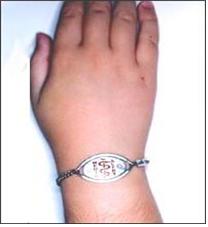
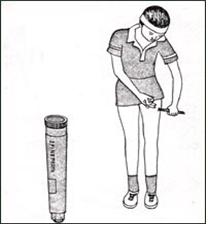
- bwww.foodallergy.org
- 우유, 달걀, 생선이나 새우 조개 등 갑각류, 나무 견과류, 밀가루 음식, 땅콩, 메주콩 등에서 나온 단백질이 든 음식물은 식품 알레르기(음식물 알레르기)를 더 잘 일으킬 수 있다. 미 음식물 회사는 음식물 성분을 소비자가 알 수 있도록 음식물 포장지에 명시하도록 Food allergen labeling and consumer protection act of 2004 에 의해서 법적으로 정해졌다(Pediatrics News October 2008).
알레르기 행진을 중지하려면 How to stop allergy march
1. 생후부터 적어도 4~12개월 까지 모유를 먹인다.
2, 모유를 먹는 동안 보충식을 먹이려면 가수화 단백 포물러를 먹인다.
3. 혼합수유(혼동수유)는 하지 않는다.
4. 고형 이유식은 생후 4개월 이전에는 먹이지 않는다.
5. 흡연하는 사람 주위에 있지 않는다.
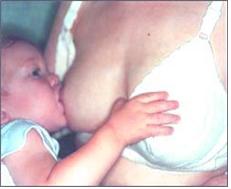
그림 137. 알레르기 행진을 예방하기 위해 모유 수유를 한다.
Copyright ⓒ 2011 John Sangwon Lee, MD., FAAP
|
다음은“두드러기, 답변 고맙습니다”에 관한 인터넷 소아청소년 건강상담 질의응답의 예 입니다. |
Q&A. 아이가 음식 두드러기가 있어요
Q.
그리고 몇 가지 더 여쭈어 보겠습니다. 많은 종류의 음식을 줄이고(유제품 포함)야채와 과일 쇠고기만 섭취해도 될런지요. 두달 동안 3kg가 빠졌는데 앞으로도 계속 몸무게가 빠지지는 않는지 걱정이 됩니다. 그렇게만 먹여도 아이 건강에 괜찮은지요. 그리고 언제까지 그렇게 해야되는지… 지금 아이가 19kg입니다.
A.
- 심봉사님
- 안녕하세요.
- 질문해 주셔서 감사합니다. 좋은 질문입니다.
- 자녀의 나이, 성별, 과거 병력, 가족 병력, 진찰소견, 임상검사 등의 정보를 많이 알수록 답변을 드리는데 도움이 됩니다. 주신 정보를 토대로 해서 답변을 드리겠습니다.
- 저는 다시 질문을 하실 줄 믿고 질문을 기다리고 있는 중 질문해 주셔서 대단히 고맙습니다.
- 지금은 어떤지요. 제가 한국에 6주 동안 다녀오면서 또 이곳에서 소아청소년과 의사 생활을 하면서 많이 생각해 본 한국 음식문화에 대해서 좀 말씀드리면 거기에 답변이 있을 것입니다.
- 몇 년 전에 연세대학교 가정대학 모 교수님 한 분을 저희 집에 모시고 식사를 대접하게 되었습니다.
- 그때 한국 음식문화에 대해서 잠시 동안 이야기를 나누었습니다.
- 제가 한국을 방문했을 때마다 한국에서 경제적으로 풍부하고 여러 모로 잘 사시는 댁에 초청받아 갔을 때 우유와 우유로 만든 음식물을 저에게 일체 주지 않더라고 말씀드리면서 한국 가정에서는 왜 우유를 많이 먹지 않느냐고 물었더니 그 분께서 “한 민족의 음식문화는 3대를 거쳐서 정해지고 음식물의 종류도 선정된다.”고 말씀하셨습니다.
- 아이들이나 성인들이
- 확실한 이유 없이 배가 아프다고 호소하거나
- 변비가 생기거나
- 방귀를 자주 많이 뀌거나
- 기운이 없거나
- 알레르기 질환이 많이 유발되면
- 저는 “우유를 얼마나 먹습니까“하고 질문을 우선해봅니다.
- 부모가 요리한 집 음식물 대신 음식점 음식물을 얼마나 자주 먹는지 또는 조미료, 음식물 색을 내는 화학 물질, 음식물을 오래 동안 보관 할 수 있게 쓰는 화학물질이 든 음식물을 얼마나 먹고 있는지 알아봅니다.
- 그 때 10중 팔구 또는 거의가 우유나 우유가 든 음식물을 많이 먹고 있다는 것을 발견할 수 있었습니다. 그리고 패스트 음식물(패스트 푸드)을 먹고 있는 것을 알 수 있습니다.
- 우유는 좋은 음식물이지만 우유나 우유 음식물로 설사, 복통, 두드러기, 기관지 천식, 알레르기 비염, 혈뇨, 혈변, 긴장성 피로증후군, 행동과다증(과도활동장애), 집중력 결여증(주의력 결핍 장애) 등 여러 가지 증상과 징후와 병이 유발될 수 있습니다.
- 집에서 요리한 음식물 이외 많은 종류의 패스트 푸드와 편의점 등에서 사서 먹을 수 있는 많은 종류의 음식물 성분에는 MSG(Monosodium glutamate/Sodium glutamate) 및, 또는 우유나 인공색소, 방부제 등이 들어있을 수 있습니다.
- 심지어는 음식물이 부패되지 않고 오랫동안 보관할 수 있도록 음식물 장기보관용 화학물질이나 항생제도 음식물에 넣기도 합니다.
- 잘 아시겠지만 MSG가 든 음식물을 중국 음식점에서 먹고 구토, 설사, 복통, 두통, 두드러기 등의 MSG 부작용이 유발될 수 있습니다. 그렇게 생긴 병을 중국 음식점 증후군 Chinese Restaurant Syndrome이라고 합니다.
- 그 외 인공 색소나 MSG 또는 설탕이 많이 든 음식물을 먹고 행동과다증(과도 활동 장애)과 집중력 결여증이 유발될 수도 있습니다.
- 밀가루나 보리 음식물로 글루텐 유발 장증(셀이악 병)이 유발될 수 있습니다. 글루텐 유발 장증으로 설사를 할 수 있고 관절염도 유발될 수 있고 우울증 등 정신적 문제도 유발될 수 있습니다.
- 호두 음식물, 새우, 어패류 등의 음식물로 식품 알레르기가 유발될 수 있고 두드러기가 날 수 있습니다.
- 말씀을 다 드리려면 끝이 없습니다.
- 다행히도 쌀밥으로는 알레르기 질환이 잘 유발되지 않고 고기 음식물 중에 쇠고기나 양고기로 식품 알레르기가 가장 적게 유발됩니다.
- 즉 음식물에서 탄수화물 성분으로서 쌀밥을, 단백질 성분으로서 소고기를 섭취하면 됩니다(소고기 값이 비싸기는 하지만).
- 좋아하면 얼마든지 오랫동안 섭취해도 됩니다.
- 물론 감자, 호박 등의 음식물로 알레르기 질환이 잘 유발되지 않습니다.
- 참깨도 알레르기 질환을 유발시킬 수 있지만 참깨기름과 소고기에 있는 지방은 또한 매일 필요로 하는 지방질 영양분의 자원이 될 수 있습니다.
- 다른 종류의 식물성 식용기름을 적절히 섭취하면 필수지방을 충분히 할 수 있습니다.
- 요즘 문헌에 의하면 이스라엘 사람들에게 참깨 음식물로 알레르기 질환이 잘 유발된다고 합니다.
- 토마토, 사과, 귤 등 풍성한 채소와 과일 주스 등에서 각종 비타민, 미네랄 등을 섭취할 수 있습니다.
- 거기다가 맹물이나 보리차 등을 섭취하면 좋을 것입니다.
- 음식물을 요리하고 먹는 것도 하나의 음식물 문화 예술이라고 할 수 있습니다.
- 음식물 알레르기를 잘 일으키지 않는 음식물을 2~4주 동안 주다가 새 종류의 음식물을 거기다가 한 가지씩 첨가하기 시작하면서 어떤 음식물이 아기에게 가장 좋은가, 어떤 음식물이 아기에게 문제가 생기는지 찾아보십시오.
- 그 다음부터 많은 종류의 음식물 재료로 음식물을 만들어 먹일 수 있습니다.
- 그러나 언제든지 조심해서 새 음식물을 추가해 먹이도록 하십시오.
- 상당히 어려운 일이지요.
- 그렇습니다.
- 이런 음식물을 먹을 때 아기에게만 그런 종류의 음식물을 따로 먹이지 말고 전 식구들이 거의 같은 음식물을 먹는 것이 좋습니다.
- 전 식구들이 그렇게 먹다보면 우리 조상들이 즐겨 자셨던 음식물을 우리들이 먹어야 하는 경우도 있다는 것입니다. 그래도 걱정이 되면 영양사와 상담하십시오.
- [부모도 반의사가 되어야 한다–소아가정간호백과]-제9권 소아청소년 소화기 질환–글루텐 유발 장증(셀이악 병)으로 인한 설사, 복통, 우유 단백 알레르기로 인한 위장염 등을 참조하시기 바랍니다.
- 두드러기 참조
- 질문이 더 있으면 다시 연락해 주시기 바랍니다.
- 감사합니다.
- 이상원 드림
식품 알레르기(음식물 알레르기)의 증상 징후 Symptoms and signs of food allergy
- 음식물에 의한 식품 알레르기가 신체의 한 계통의 한 기관에만 유발될 수도 있고 한 국소에만 생길 수도 있고, 여러 계통의 여러 기관에 동시 유발될 수도 있고, 전신 모든 계통의 전 기관에도 유발될 수 있다.
- 식품 알레르기는 급성으로도 유발될 수 있고, 아 급성으로 유발될 수 있고, 만성으로 유발될 수 있다.
- 식품 알레르기로 생기는 아나필락시스(과민반응)은 급성 음식물 알레르기이다.
신체의 각 계통이나 기관에 생기는 음식물 알레르기(식품 알레르기)의 증상 징후는 다음 각항을 참조.
- 호흡기에 생길 때 – 콧물, 비염, 천식, 천명, 협착음
- 피부계에 생길 때 – 두드러기, 피부홍저, 혈관 부종, 접촉성 피부염, 두드러기, 아토피 피부염의 증상 징후가 더 심해지는 등
- 소화기에 생길 때 – 구토, 복통, 설사 등
- 중추신경계에 생길 때 – 음식물 기피증, 감정의 변화, 우울증, 과도 활동장애, 주의력 결핍증, 편두통
- 근육골격계에 생길 때 – 근육 골격통, 성장통 등
- 심장 혈관계에 생길 때 – 가성 빈혈, 편두통 등
- 그 외 증상 징후
음식물 알레르기의 발생률 The occurrence rate of food allergy
- 음식물로 유발된 소아 식품 알레르기가 0.5~10%정도 발생된다.
- 어린 영유아들에게 소아 식품 알레르기가 유발될 수 있고 소아 천식 환자들의 3.5%가 식품 알레르기로 소아 천식이 유발된다고 한다.
- 성인들의 19.4%에서 음식물 불내증이 생기고 음식물 알레르기는 약 3.2% 생긴다.
- 음식물 유발 식품 알레르기의 80%가 1세 이전 영아기에 생기고 그 후 발생률이 점점 감소되는 것이 보통이다.
- 아이들의 음식물 알레르기의 ⅔는 우유 음식물에 의해서 생긴다.
- 그러나 과일, 과일주스류 음식물 등에 의해 유발될 수 있다.
- 3.7~7.5%의 아이들에게 우유 알레르기가 발생된다. 우유를 더 이상 먹지 않으면 알레르기가 없어지고 다시 먹으면 재발되는 것이 보통이다. 우유를 섭취한 수유모의 젖을 먹어도 우유 알레르기가 유발될 수 있다.
- 더 많은 음식물 알레르기에 관한 정보는 음식물 알레르기, 식품 알레르기, 식품 알러지 참조.
| 연구에 따라 음식물 알레르기 발생률의 차이가 있다. |
호흡기 식품 알레르기 Food allergy of the respiratory system
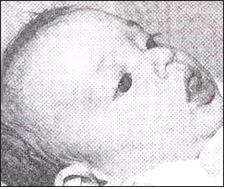
사진 138. 음식물이나 다른 종류의 항원으로 알레르기 비염 등이 유발되면 그로 인해 코가 막혀 입을 벌리고 입으로 숨을 쉬는 구강 호흡을 한다.
Used with permission from Annals of Allergy, Vol, November 8, 2008
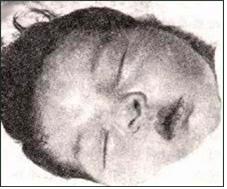
사진 139. 음식물이나 다른 항원으로 알레르기 비염 등이 유발되면 그로 인해 코가 막혀 입을 벌리고 입으로 숨을 쉬는 구강 호흡을 할 수 있다.Used with permission from Annals of Allergy, Vol, November 8, 2008
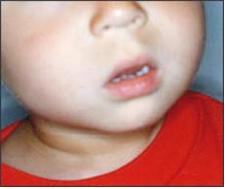
사진 141. 음식물이나 다른 항원으로 알레르기 비염 및 아데노이드 비대 등이 유발될 수 있다. 그로 인해 코가 막히고 비강, 인두 강이 좁아져 입을 벌려 숨을 쉴 수 있다. 코를 골고, 폐쇄성 수면 무호흡증도 유발될 수 있다. Copyright ⓒ 2011 John Sangwon Lee, MD.FAAP
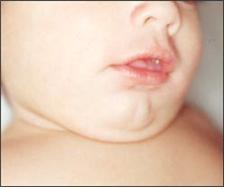
사진 140. 음식물이나 다른 항원으로 알레르기 비염이 유발될 수 있다. 그로 인해 코가 막혀 입을 벌리고 숨 쉬는 것이 보통이다. 이런 징후를 게이핑, 구강호흡 또는 경구호흡이라고 한다. Copyright ⓒ 2011 John Sangwon Lee, MD., FAAP
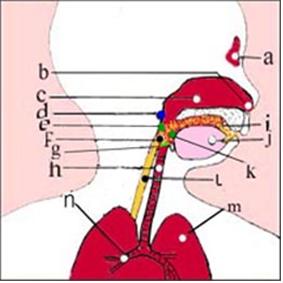
그림 142. 부비동(a)에 알레르기 부비동염, 콧구멍과 비강(b)이 가렵고, 비강 점막층(c)에 알레르기 비염, 아데노이드(d)에 아데노이드 비대, 혀(j)에 알레르기 설염이나 지도형 설염, 편도(e와 k)에 편도 비대, 인두(f)가 가렵고, 후두(g)에 알레르기 후두염, 기관(h)과 기관지(n)에 기관지 천식, 폐(m)에 알레르기성 폐렴 등 호흡기계 알레르기 질환이, 소화기계에 식품 알레르기가 유발될 수 있다. Copyright ⓒ 2011 John Sangwon Lee, MD., FAAP
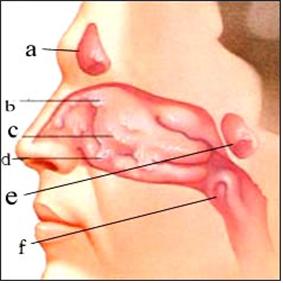
그림 143. 알레르기 비염이 식품 알레르기로 유발될 수 있다.
a-전두동에 알레르기성 전두동염, b, c, d-알레르기 비염으로 분 비강 점막층과 분비물(콧물), e-알레르기성 접형동염, f-알레르기 비염으로 분 구씨관(이관)의 비인두강 입구
Used with permission from Schering Corporation Kenilworth, NJ 07033
- 음식물(식품)로 유발되는 소아청소년 식품 알레르기는 소아 청소년들의 0.5~10%가 발생된다
- 대표적인 소아 식품 알레르기는 아토피 피부염, 위장관 장애, 알레르기 비염, 음식물 아나필락시 반응, 두드러기, 천식 등이다.
- 특히 신생아들, 영유아들에게 소아 식품 알레르기가 더 잘 유발될 수 있고 3.5%의 소아 천식이 식품 알레르기로 유발된다고 한다.
- 어떤 음식물이든 식품 호흡기계 알레르기가 유발될 가능성이 있다.
- 알레르기 비염, 알레르기 안염, 안구주위 소양증, 눈물, 비강 충혈, 재채기 등의 증상 징후는 식품 알레르기성 호흡기 질환의 대표적인 증상 징후이다. 그래서 통년성 알레르기 비염이 유발될 수 있다.
- 알레르기 비염, 알레르기 안염은 나무나 풀의 화분, 몰드, 집 먼지 진드기(집먼지 좀 진드기), 애완동물의 비늘, 침, 털 등으로도 유발될 수 있다.
- 따라서 알레르기성 비 안염이 유발 될 때 식품 알레르기로 유발됐는지 나무나 풀의 화분, 몰드, 집 먼지 진드기(집먼지 좀 진드기), 애완동물의 비늘이나 털 등으로 유발되었는지 감별 진단해야 한다.
- 알레르기 비염을 유발시키는 음식물을 계속 먹으면 그 음식물로 알레르기 비염이 일 년 내내 계속 되여 일 년 내내 감기에 걸린 것처럼 콧물을 흘리고 재채기를 하고 코가 자주 막힐 수 있는 증상 징후가 나타난다.
- 흔하지 않지만 식품 알레르기로 천식이 유발될 수 있으나 그 원인 관계를 확실히 증명하기가 곤란하다.
- 과거에 천식을 앓았던 병력이 있는 소아청소년들이 천식을 유발시킬 수 있는 음식물을 먹을 때 그들에게 간헐 천식, 경도 지속 천식, 또는 중증 지속 천식이 발작될 수 있다.
- 식품 알레르기로 천식발작이 심하게 유발되면 숨을 가쁘게 쉬고, 숨 쉴 때 그렁그렁 소리를 내거나 쌕쌕거리며 기침을 할 수 있고 때로는 천명만 날 수 있다.
- 식품 알레르기가 후두에 유발되면 후두 소양감, 후두 협착음(Stridor), 음식물을 넘기기가 어렵고, 발음을 제대로 할 수 없고 목이 쉬고 가래 없는 기침만 하는 등의 증상 징후가 유발될 수 있다(참조문헌;Pediatric annals, vol 37, November 8, 2008).
Food allergy (food allergy/food allergy/food allergy) 식품 알레르기(음식물 알레르기 /음식물 알러지/음식 알레르기)
Food (food) can cause the following problems
① Food adverse reaction may be induced and
② Food hypersensitivity (food allergic reaction/Food hypersensitivity) can be triggered,
③ Food anaphylaxis can be triggered
④ Food intolerance can be caused.

Photo 132. Foods that can most commonly cause food allergies in children and adolescents (ages 0-18). Eggs, milk, peanuts, soybeans, wheat foods, tree nuts (walnuts, pecans, pistachios, Brazilian walnuts, etc.), shellfish, and fish are the most likely triggers of food allergies. It is said that 95% of food allergies in children are caused by eggs, milk, peanuts, or soybeans. Copyright ⓒ 2011 John Sangwon Lee, MD., FAAP
Overview and incidence of food allergy (food allergy)
• Food-induced allergies are called food allergy, food allergies, food allergies, food allergies, food allergies, plant allergies, food allergies, or digestive tract allergies.
• IgE-mediated food allergies occur in 6-8% of children in the United States or in the UK, and in 2% of adults (source; The New England Journal of Medicine, Sep. 18, 2008).
• There are studies showing that IgE-mediated food allergies can cause as much as 25% of adults, but in practice less than 3% of them occur.
• In the United States, food allergies result in 30,000 people receiving first aid and nearly 2,000 deaths per year.
• Most of the food allergies in young infants and toddlers disappear naturally as they grow gradually, but allergies to tree nut foods such as peanuts, walnuts, pecans, pistachios, and Brazil walnuts, fish and shellfish, and seafood food allergies in infants and toddlers do not disappear completely and persist throughout life. Can be.
• Glycoprotein (sweet protein) in animal or vegetable foods can cause food allergies.
• Foods such as eggs, milk, peanuts, tree nuts, and sesame seeds are the most common causes of food allergies in infants and young children.
• Recently, kiwi allergy is on the rise.
• Food allergies can be triggered by wheat or soybean meals, but it is difficult to diagnose clinically with certainty.
• It is said that 95% of food allergies in children and adolescents are mainly caused by four foods: eggs, milk, peanuts and soybeans, Reference-③.
• In adults, food allergies are most commonly caused by foods such as shellfish, seafood, fish, peanuts and tree nuts.
• The incidence of food allergies varies from country to country and region to region. For example, there are many mustard food allergies in France, sesame allergy in Israel, and egg food allergy, milk, and milk food allergies regardless of country, region, or region (Source: Food allergy, The New England Journal. of Medicine, Sept. 18, 2008).
• Egg food allergies occur in 1.5% to 3.2% of children and adolescents. It is said that 66% of allergies caused by egg food can disappear by the age of 5, and 75% by the age of 7. It is said that if the egg food allergy does not go away by the age of 16, it will last for a lifetime.
• Food allergies are more common in children with atopic constitution than in children without atopic constitution
• Children with atopic constitution are more likely to develop allergic diseases from food, so it is assumed that any type of food can cause food allergies, and food should be covered.
• Symptoms resulting from a disease other than a food allergy may be similar to those resulting from a food allergy. Therefore, symptoms caused by any other disease are often mistakenly judged as symptoms or signs of food allergy.
• For example, symptoms or symptoms of lactose intolerance, food poisoning, gastrointestinal infections, and neuropsychiatric disorders may be similar to those of food allergies. Therefore, lactose intolerance, food poisoning, or infectious diseases can be misdiagnosed as food allergies.
• Sometimes, the same symptoms as those of a food allergy can be caused by a disease other than a food allergy.
• Lactose intolerance, for example, can be roughly the same as abdominal pain resulting from a milk protein allergy. For this reason, it is necessary to differentially diagnose the symptoms caused by food allergies and those caused by other diseases. ‘
www./drleepediatrics.com-Volume 5 artificial nutrition, baby food, vitamins, minerals, fats, Protein-if your baby cannot eat artificial nutrition made from milk,
• See Volume 12 Pediatric Neurology, Mind, Emotion, Behavior, Psychology, and Sleep Problems-Simple Tic.

Picture 133. Foods such as milk, eggs, peanuts, nuts, fish, and flour can cause food allergies better. Copyright ⓒ 2011 John Sangwon Lee, MD., FAAP

Picture 134. Milk or foods made from milk may cause food allergies better. Copyright ⓒ 2011 John Sangwon Lee, MD., FAAP Causes of food allergy (food allergy)
1. Food allergy caused by the mediated immunoglobulin E (IgE)
• The primary target organs for food allergy caused by immunoglobulin E (IgE) are the digestive system such as the oral cavity and pharynx, and the secondary target organs are skin, lungs and blood vessels.
1) Oral allergy syndrome-swelling of the lips, mouth, or pharynx and itching may occur.
2) Gastrointestinal anaphylaxis symptoms of gastrointestinal disorders such as goji, vomiting, epigastric abdominal pain, abdominal distension, farting, and diarrhea may occur.
3) Acute urticaria, angioedema, and atopic dermatitis can be induced on the skin. Bronchial asthma and or allergic rhinitis may be caused,
4) Anaphylaxis- Shortness of breath, cyanosis, hypotension, shock, and other symptoms may occur.
2. Mixed food allergy caused by immunoglobulin E (IgE) and non-immunoglobulin E (IgE)
1) Atopic dermatitis
• Parents should also be anti-doctors-Refer to the Encyclopedia of Pediatrics and Family Nursing-Volume 17 Child and Adolescent Skin Diseases-Atopic Dermatitis
2) Allergic eosinophilic esophagitis
• ww.drleepediatrics.com-Volume 9, Children and Adolescents Digestive System Diseases-Eosinophilic Esophagitis
3) Allergic eosinophilic gastroenteritis
• Symptoms such as goji, vomiting, diarrhea, and severe epigastric abdominal pain may occur.
• The number of eosinophils in the blood increases and the walls of the gastrointestinal tract are also increased.
• The skin test for the food that caused the allergy is positive, and eating the food makes symptoms worse.
3. Food allergy caused by non-immunoglobulin E (IgE)
1) Food protein-induced proctocolitis
2) Food protein-induced enterocolitis source; Pediatric annals, vol 37, November 8, 2008.
More specifically about food allergies
• Allergic rhinitis caused by pollen is caused by IgE-mediated, and most of the oral food allergies, which cause itching in the mouth or tingling symptoms in the mouth, are caused by IgE-mediated.
• Food allergies caused by IgE mediation usually occur only seconds to minutes after eating the food.
• It can be triggered late within an hour or two after eating.
• Small intestinal colitis caused by milk protein allergy or soy protein allergy is T-cell mediated. Food allergies caused by T-cell mediation usually occur 3 to 4 hours after eating.
• Food allergies can affect 5 to 8% of children, but food adverse reactions that are not food allergies can cause as much as 25%.
• Foods such as milk, eggs, peanuts, soybeans, flour, shellfish, fish, walnuts, nuts, and chocolate may cause food allergies more than other types of foods.
• There are studies showing that rice protein allergy caused small intestinal colitis, but in general, rice foods are low-allergic foods (source; Journal watch pediatrics and adolescent medicine vol #1).
• Mild milk allergies or egg allergies may no longer develop as they grow, but peanut or tree nut allergies can persist throughout life, regardless of growth.
Symptoms, signs of food allergy (food allergy)
• Food allergies caused by IgE-mediated food allergic reactions may appear only in one organ of the body, may appear simultaneously in several organs of the body, may appear throughout the body, or only in one area of the body’s marginal pain. Can appear.
• IgE-mediated food allergy can cause local hives and cause anaphylactic reactions.
Egg-egg syndrome (Occupational egg allergy)
• In the process of making medicines or foods containing egg protein, even if a minute amount of egg protein is contained, the egg protein component may cause egg allergy.
• This symptom is called egg-egg syndrome. (See; Food allergy, The New England Journal of Medicine, Sep. 18, 2008).
Refer to the following sections for symptoms and signs of food allergy caused by various organs of the body.
• When it occurs in the respiratory system-runny nose, rhinitis, asthma, wheezing, etc.
• When it occurs in the skin and mucous layers-hives, skin redness, angioedema, contact urticaria, more severe symptoms and signs of atopic dermatitis, etc.
• When it occurs in the digestive system-vomiting, abdominal pain, diarrhea, etc.
• When it occurs in the central nervous system-food avoidance, emotional change, depression, etc.
• When it occurs in the musculoskeletal system-musculoskeletal pain, growth pain, etc.
• When it occurs in the cardiovascular system-pseudo anemia, migraine
• When it occurs in other branches or organs
First age at which food allergies begin to develop
1. Egg food allergy-6 to 24 months old
2. Milk food allergy-6-12 months old
3. Peanut food allergy-6 to 24 months old
4. Tree Nut Food Allergy-1-17 years old
5. Sesame food allergy-6 to 36 months old
6. Fish Food Allergy-Late Puberty or Adulthood
7. Shellfish Food Allergy-Adult
8. Wheat flour food allergy-6 to 24 months old
9. Meju bean food allergy-6~24 months after birth
10. Kiwi Food Allergy-Any Age
11. Apple Food Allergy-Late Puberty and Adulthood
12. Carrot Food Allergy-Late Puberty and Adulthood
13. Peach Food Allergy-Late Puberty and Adulthood Source-Food allergy, The New England Journal of Medicine, Sep. 18, 2008
Diagnosis of food allergy (food allergy)
• It is common to diagnose food allergies based on medical history, symptoms, and medical examination findings. • If necessary, to determine the concentration of IgE antibody (immunoglobulin E antibody) in the blood. • Blood test
• Allergic skin thorn (extreme) test
• Provocation test
• Radiation allergen absorption test (RAST) to test for IgE
• Skin biopsy or small intestine mucosa biopsy, if necessary
• Gastrointestinal endoscopy, etc.
• Diagnose food allergies with one or several of the tests listed above.
• Among them, the patient’s past and present medical history and family medical history are the most valuable in diagnosing food allergies.
• When diagnosing a food allergy, after stopping eating the food that causes the food allergy, you can diagnose by seeing whether the symptoms of the food allergy disappear or are less, or there is no remission or remission.
• At the same time as diagnosing food allergies, it means treating food allergies.
• Symptoms of a food allergy usually disappear if foods that are thought to cause food allergies related to IgE antibodies are not consumed for 1 to 2 weeks.
• Most of the symptoms of small colitis caused by food allergies usually disappear 3 to 6 weeks after stopping eating food that caused the food allergy.
• Children with food allergies caused by foods such as milk, eggs, and peanuts usually have elevated blood levels of IgE antibodies in food proteins such as milk, eggs, and peanuts.
• If the result of a specific food allergy skin test is positive, it means that antibodies to that food (antigen) are present in the subject’s body. However, just because a skin test result is positive cannot guarantee that a food allergy may be caused by the food. Provoking tests as follows www.drleepediatrics.com -Volume 9 Children and adolescents digestive problems Can be diagnosed.
Food allergy (food allergy) trigger test
• Trigger tests can be done at home, as directed by a doctor, only if the symptoms of a food allergy are mild and the trigger test does not pose a risk. Otherwise, the doctor will do it.
• Nevertheless, whether the symptoms of a food allergy are mild or severe, it is safe and ideal to run a trigger test by an allergist.
• Do not consume any foods suspected of causing food allergies for 2 to 4 weeks.
• While observing the food suspected to have been triggered without eating for 2 to 4 weeks, carefully observe whether symptoms of a previous food allergy persist, do not occur, or are less severe.
• If the symptoms of food allergy do not develop significantly or less during observation for 2 to 4 weeks, it can be assumed that food allergy is caused by the food, but it is clearly diagnosed that food allergy was caused by the food that was estimated during the provocation test. I can’t.
• When the food is consumed again, the symptoms of a food allergy reappear again, but if the same symptoms occur when eating the food by observing it carefully, it is possible to presume that a food allergy is’possibly’ with the food. .
• Even if a minor food allergy has occurred with any food in the past, the patient himself or the child’s parent or guardian should never perform a trigger test at will without the permission of a doctor to diagnose a food allergy caused by food.
• The principle of the provocation test is to perform a provocative test in a hospital where allergy specialists can perform progressive CPR immediately in the field just in case.
• Parents should never do a trigger test at home to diagnose severe food allergies in their children.
There was also an example of a young man who died after eating a shrimp due to anaphylaxis.
Differential diagnosis of food allergy (food allergy)
When cooking food
o Various artificial food colorings such as added tartrazine (Tartrazine, E number E102 or C.I. 19140, FD&C Yellow 5),
o Chemical seasonings such as monosodium glutamate,
o Symptoms of side effects caused by food preservatives such as nitrites are similar to those of food allergies. o These types of chemical food ingredients can cause attention deficit and hyperactivity disorder.
o When eating milk from cows that have been treated with penicillin or several other antibiotics, the antibiotics in the milk can cause anaphylaxis. Anaphylaxis is a type of food allergy and is a severe, immediate allergic reaction that is dangerous to life.
• Symptoms or illness caused by food containing bacteria, molds, drugs, or insects.
• Mushroom poisoning, shellfish poisoning
• Gastrointestinal diseases such as peptic ulcer, diaphragmatic hernia, and intestinal obstruction
• Primary disaccharide enzyme deficiency, secondary disaccharide enzyme deficiency, galactose, etc.
• Symptoms caused by foods containing drug ingredients-Symptoms caused by foods containing alcohol, histamine, caffeine, etc.
• Signs of symptoms caused by endocrine disorders
• Symptoms caused by bacterial, viral, or parasitic infections
• Signs of symptoms caused by psychological problems
• etc Sources and references; Clinical Seminar, Richard Evans, III, M.D., M.P.H and Richard J. Summers, M.D.
Food allergy (food allergy) treatment and prevention
• Almost all foods are likely to cause food allergies, but foods such as milk, eggs, peanuts, seafood, or tree nuts are the most likely to trigger food allergies.
• Some children have specific foods that can cause food allergies.
• Not eating that particular food is the prevention of food allergies and is also the first treatment.
• Recently, a boyfriend with a peanut allergy developed a peanut allergy after kissing his girlfriend who ate peanut butter and died of anaphylaxis.
• Prevent and treat food allergies by avoiding eating or contacting foods that may cause allergies (it is difficult, but must be practiced).
• The American Academy of Pediatrics and Adolescents recommends that parents with atopic constitutions do not feed their newborn infants with milk and milk food at all until at least 6-12 months of age.
• We live in a world where foods that do not contain milk protein are hard to find.
• Eggs at least 12 to 24 months old,
• He stressed that not feeding peanuts, tree nuts, or fish foods until the age of 2-4 is a good way to prevent food allergies.
• Parents and siblings have many types of allergic diseases in the past or present, have atopic constitution, or have food allergies such as milk, eggs, chocolate, beans, tree nuts, etc. Parents, siblings, and siblings should avoid eating those kinds of food as directed by a doctor, as far as possible.
• Long before delivery, you should consult with your doctor to decide whether to breastfeed or feed your baby with artificial nutrition.
• By breastfeeding, I can make food allergies less provoking to my beloved baby.
• Nursing mothers themselves should avoid foods that cause food allergies.
• In order to prevent food allergies, babies should be prepared to breastfeed during pregnancy instead of artificial nutrition as much as possible.
• If any of your parents’ siblings have an atopic constitution, it is recommended that you breastfeed your baby instead of artificial nutrition.
• Just as cessation education, sex education, habitual drug education, and safety accident prevention education are basically provided to adolescent children during regular health check-ups at the Department of Pediatrics and Adolescents, it would be good if the obstetrics and gynecology department provided basic breastfeeding encouraging education for all pregnant women.
• This kind of education is one of the paths to becoming a cultural bureau. [Parents should also be anti-doctors-Pediatric Family Nursing Encyclopedia]-Volume 4 Breast Milk, Breastfeeding, Reasons-Refer to Breast Milk and Allergies.
• Foods that have definitely triggered food allergies in the past, or foods that have been presumed to have triggered food allergies, should not be eaten again until they are clearly identified.
• Children with food allergies are more likely to develop allergic diseases from house dust, house dust mites (house dust mites), animal hair or dandruff, or saliva, pollen, and mold.
• Avoid or eliminate as much as possible things that may well trigger allergic diseases (antigens). No further contact should be made.
• When anaphylaxis develops after eating certain foods, bee stings, or after being treated with certain drugs, the child himself/herself usually carries epinephrine injections or epiphene auto-injection drugs, which can be treated as an emergency, and injects them immediately when necessary. Keep it in your home, car, etc. so that you can.
• If food anaphylaxis occurs, the child or a person around him or her should inject anaphylaxis into the child according to the doctor’s prescription for first aid.
• Regardless of the cause of anaphylaxis, when anaphylaxis develops, immediate emergency treatment is required with epinephrine or EpiPen auto-injection drugs, or Anakid auto-injection drugs.
• Go to the nearest hospital or general hospital emergency room for treatment according to the instructions of a medical paramedic, a regular pediatrician, or hospital emergency room. • Never try to eat food that caused anaphylaxis again. See drug-induced anaphylaxis
• For children with food allergies or children with atopic constitutions, it is difficult to do this, but before eating packaged fast foods, purchased foods, or foods bought outside the house, you should find out what kind of ingredients they contain.
• After confirming that the ingredients of the food that caused the food allergy in the past are contained in the food, you must eat food that does not contain the food ingredients that caused the food allergy.
• I think food ingredient labeling should be implemented as a national policy.
• Treat food allergies symptomatically according to the symptoms and signs of a food allergy.
• Feed as much breast milk as possible, especially for newborns or infants born from parents with atopic constitution.
• While breastfeeding infants with atopic constitution and any other allergic disease, breastfeeding mothers avoid eating as much food as possible, such as milk, eggs, and chocolate, which can cause allergic diseases. www.drleepediatrics.,com-Volume 4 Breast Milk, Breastfeeding, Reasons-Refer to Breast Milk and Allergies.

Photo 135. Children who have had some food anaphylaxis in the past should wear a bracelet or necklace with a mark with the name of the food that caused the anaphylaxis. Copyright ⓒ 2011 John Sangwon Lee, MD., FAAP

Picture 136. A child who has had some food anaphylaxis in the past may have anaphylaxis again due to the same type of food ingredients. Always keep the epinephrine injection drug for emergency treatment at home, school, car, or other suitable place when anaphylaxis develops. If anaphylaxis occurs, you, your parents, or someone around you will immediately give an injection for emergency treatment. Should be Copyright ⓒ 2011 John Sangwon Lee, MD., FAAP
For more information on food allergies,
• bwww.foodallergy.org
• Foods containing protein from crustaceans such as milk, eggs, fish or shrimp shellfish, tree nuts, flour foods, peanuts and soybeans may cause food allergies (food allergies). U.S. food and beverage companies have been legally enacted by the Food allergen labeling and consumer protection act of 2004 to ensure that food ingredients are identified on food packaging (Pediatrics News October 2008). How to stop allergy march
1. Breastfeed from birth to at least 4-12 months.
2, to feed supplementary diet while breastfeeding, feed the hydrolyzed protein formula.
3. Mixed feeding (mixed feeding) is not allowed.
4. Do not feed solid baby food before 4 months of age.
5. Not around people who smoke.

Figure 137. Breastfeeding to prevent an allergic streak. Copyright ⓒ 2011 John Sangwon Lee, MD., FAAP
The following is an example of an Internet pediatric and adolescent health counseling question and answer on “Thank you for your answer, Hives”.
Q&A.
Child has food hives
Q. And I’ll ask you a few more questions. You can cut down on many types of food (including dairy) and eat only vegetable and fruit beef. I’ve lost 3kg in two months, and I’m worried about losing weight in the future. Is it okay for the child’s health to feed just that way? And how long do we have to do that… Now the child is 19kg A.
• Shim Bong-sa • Good morning.
• Thank you for asking. That’s a good question.
• The more information you know about your child’s age, gender, past medical history, family medical history, medical examination findings, and clinical examination, the more helpful it is to give you an answer. We will respond based on the information you provided.
• I’m very grateful for asking questions while I’m waiting for your questions, trusting you to ask them again.
• How is it now? If I can tell you a little about the Korean food culture that I thought a lot while visiting Korea for 6 weeks and working as a doctor for children and adolescents here, there will be an answer.
• A few years ago, a professor at Yonsei University College of Home Economics was invited to serve a meal at my house.
• At that time, we talked about Korean food culture for a while.
• Whenever I visited Korea, when I was invited to a house that is economically rich and well-lived in Korea, I told them that they didn’t give me any milk and food made with milk, and asked why Korean families don’t eat a lot of milk He said, “The food culture of a nation is determined through three generations, and the type of food is selected.”
• Children or adults
• Complaining that your stomach hurts for no apparent reason, or
• Constipation occurs
• Farts often and a lot
• no energy
• If a lot of allergic diseases are triggered
• I prioritize the question, “How much milk do you eat?”
• Find out how often parents eat restaurant food instead of cooked home food or foods that contain seasonings, chemicals that color the food, and chemicals that use foods to store food for a long time.
• At that time, it was found that eight or eight of 10 were eating a lot of milk or foods containing milk. And you can see that you are eating fast food (fast food).
• Milk is a good food, but milk or milk can be used in various ways such as diarrhea, abdominal pain, hives, bronchial asthma, allergic rhinitis, hematuria, bloody stool, tension fatigue syndrome, hyperactivity disorder (hyperactivity disorder), and lack of concentration (attention deficit disorder).
Symptoms, signs, and illness may be triggered.
• Many types of food ingredients that can be bought at convenience stores and many types of fast foods other than those cooked at home may contain MSG (Monosodium glutamate/Sodium glutamate), or milk, artificial colors, or preservatives.
• Long-term storage chemicals or antibiotics are even added to food to prevent spoilage and long-term storage.
• As you may know, eating foods containing MSG at Chinese restaurants can cause side effects of MSG such as vomiting, diarrhea, abdominal pain, headache, and hives. This disease is called Chinese Restaurant Syndrome.
• Eating other artificial colors or foods high in MSG or sugar may lead to hyperactivity (hyperactivity disorder) and lack of concentration.
• Flour or barley foods can cause gluten-induced bowel disease (celiac disease). Gluten-induced bowel disease can lead to diarrhea, arthritis, and mental problems such as depression.
• Foods such as walnut food, shrimp, and shellfish can cause food allergies and can lead to hives.
• There is no end to telling you everything
. • Fortunately, rice does not cause allergic diseases, and among meat foods, beef or mutton is the least likely to cause food allergies.
• In other words, you can eat rice as a carbohydrate component in food and beef as a protein component (although beef is expensive).
• If you like, you can take it for as long as you like.
• Of course, foods such as potatoes and pumpkins do not cause allergic diseases.
• Sesame seeds can also cause allergic conditions, but sesame oil and fats in beef can also be a source of fatty nutrients that you need every day.
• Proper consumption of other types of vegetable oils will provide you with enough essential fats.
• According to the literature nowadays, sesame foods are a common cause of allergic diseases in Israelis.
• Various vitamins and minerals can be ingested from abundant vegetables such as tomatoes, apples and tangerines, as well as fruit juices.
• In addition, it would be good to consume fresh water or barley tea.
• Cooking and eating food is also a food culture art.
• Give foods that are less likely to cause food allergies for two to four weeks, then start adding new foods one at a time to find out which foods are best for your baby and which foods are causing problems for your baby.
• From then on, food can be made and fed from many types of food ingredients. • However, always be careful to add new food to feed.
• It’s very difficult.
• That’s right.
• When eating these foods, it is recommended that the whole family eats almost the same foods rather than feeding them only those kinds of foods separately.
• If the whole family eats that way, it means that there are times when we have to eat the food our ancestors enjoyed sleeping. If you are still concerned, consult a dietitian.
• Please refer to [Parents should also be anti-doctors-Child and Family Nursing Encyclopedia]-Volume 9 Children and adolescents digestive problems-Diarrhea due to gluten-induced bowel disease (Celliac disease), abdominal pain, gastroenteritis due to milk protein allergy, etc.
• See hives
• If you have more questions, please contact us again.
• Thank you.
• Lee Sang-won .MD
Symptoms and signs of food allergy
• Food allergy caused by food may be caused only in one organ of the body, it may occur only in one area, it may occur simultaneously in several organs of several systems, or it may be caused in all organs of all systems of the body.
• Food allergies can be triggered acutely, subacutely, and chronically.
• Anaphylaxis (hypersensitivity reaction) caused by food allergy is an acute food allergy. Refer to the following sections for symptoms and signs of food allergy (food allergy) that occur in each system or organ of the body.
• When it occurs in the respiratory tract-runny nose, rhinitis, asthma, wheezing, stenosis
• When it occurs in the skin system-hives, skin redness, angioedema, contact dermatitis, hives, symptoms of atopic dermatitis are worsening, etc.
• When it occurs in the digestive system-vomiting, abdominal pain, diarrhea, etc.
• When it occurs in the central nervous system-Food avoidance, emotional change, depression, hyperactivity disorder, attention deficit, migraine
• When it occurs in the musculoskeletal system-Musculoskeletal pain, growth pain, etc.
• When it occurs in the cardiovascular system-pseudo anemia, migraine, etc.
• Other signs of symptoms The occurrence rate of food allergy
• Food-induced childhood food allergy occurs in 0.5~10%. • Childhood food allergies can be induced in young infants and young children, and food allergies in 3.5% of children with asthma are reported to cause childhood asthma.
• Food intolerance occurs in 19.4% of adults and food allergies occur in about 3.2%.
• It is common for 80% of food-induced food allergies to occur in infancy before 1 year of age, and then gradually decrease.
• Food allergy ⅔ in children is caused by milk food. • However, it can be triggered by fruits, fruit juices and other foods.
• 3.7-7.5% of children develop milk allergies. It is common for allergies to disappear when milk is no longer consumed, and to recur when the milk is eaten again. Breastfeeding from a nursing mother who has consumed milk can also lead to milk allergies.
• For more information on food allergies, see Food Allergy, Food Allergy, and Food Allergy. There are differences in the incidence of food allergies between studies. Food allergy of the respiratory system

Photo 138. When allergic rhinitis is caused by food or other types of antigens, the nose is blocked and mouth is opened and mouth breathing is performed orally. Used with permission from Annals of Allergy, Vol, November 8, 2008

Photo 139. When allergic rhinitis is caused by food or other antigens, the nose is blocked, and mouth breathing can be performed with mouth open and mouth breathing. Used with permission from Annals of Allergy, Vol, November 8, 2008

Photo 141. Food or other antigens can cause allergic rhinitis and adenoid hypertrophy. As a result, the nose is blocked and the nasal and pharyngeal cavities are narrowed, allowing you to open your mouth and breathe. Snoring and obstructive sleep apnea can also be caused. Copyright ⓒ 2011 John Sangwon Lee, MD.FAAP

Picture 140. Allergic rhinitis can be caused by food or other antigens. As a result, it is common to breathe with your mouth open because your nose is blocked. These signs are called gaping, mouth breathing, or mouth breathing. Copyright ⓒ 2011 John Sangwon Lee, MD., FAAP

Figure 142. Allergic sinusitis to the sinuses (a), itchy nostrils and nasal cavity (b), allergic rhinitis to the nasal mucosa (c), adenoid hypertrophy to adenoids (d), allergic glossitis or geographic glossitis on the tongue (j), Respiratory system allergy such as tonsil enlargement in the tonsils (e and k), itching in the pharynx (f), allergic laryngitis in the larynx (g), bronchial asthma in the trachea (h) and bronchi (n), and allergic pneumonia in the lungs (m) Diseases can cause food allergies in the digestive system. Copyright ⓒ 2011 John Sangwon Lee, MD., FAAP

Figure 143. Allergic rhinitis can be caused by food allergies. a-frontal sinus with allergic frontal sinusitis, b, c, d-allergic rhinitis nasal mucosa and secretions (runny nose), e-allergic sphenoid sinusitis, f-allergic rhinitis at the entrance of the nasopharynx Used with permission from Schering Corporation Kenilworth, NJ 07033
• Food allergy in children and adolescents caused by food (food) occurs in 0.5 to 10% of children and adolescents.
• Typical children’s food allergies are atopic dermatitis, gastrointestinal disorders, allergic rhinitis, food anaphylaxis, hives, and asthma.
• Food allergies in children, especially newborns and infants, are more likely to be induced, and 3.5% of children’s asthma is caused by food allergies.
• Any food has the potential to cause food respiratory allergies.
• Symptoms such as allergic rhinitis, allergic blepharitis, periocular itching, tears, nasal congestion, and sneezing are typical symptoms of food allergic respiratory disease. So perennial allergic rhinitis can be triggered.
• Allergic rhinitis and allergic blepharitis can also be caused by tree or grass pollen, molds, house dust mites (house dust mites), pet scales, saliva, and hair.
• Therefore, when allergic rhinitis is caused, it is necessary to differentiate whether it is caused by a food allergy, a pollen of trees or grass, a mold, a house dust mite (a house dust mite), or a pet’s scale or hair.
• If you continue to eat foods that cause allergic rhinitis, allergic rhinitis continues throughout the year, causing symptoms such as runny nose, sneezing, and frequent stuffy noses, as if you had a cold all year round.
• Although not common, food allergies can cause asthma, but it is difficult to clarify the causal relationship.
• Children and adolescents with a history of asthma in the past may have intermittent asthma, mild persistent asthma, or severe persistent asthma when eating foods that may cause asthma.
• If a food allergy triggers a severe asthma attack, you can breathe shortly, make a grunt or wheeze when you breathe, and sometimes wheeze.
• A food allergy triggered in the larynx can lead to symptoms such as laryngeal itching, laryngeal stenosis, difficulty passing food, inability to pronounce properly, sore throat and only a phlegm-free cough (see literature; Pediatric annals, vol 37, November 8, 2008).
출처 및 참조 문헌 Sources and references
- NelsonTextbook of Pediatrics 22ND Ed
- The Harriet Lane Handbook 22ND Ed
- Growth and development of the children
- Red Book 32nd Ed 2021-2024
- Neonatal Resuscitation, American Academy Pediatrics
- www.drleepediatrics.com제8권 소아청소년 호흡기 질환
- www.drleepediatrics.com제9권 소아청소년 소화기 질환
- www.drleepediatrics.com제10권. 소아청소년 신장 비뇨 생식기 질환
- www.drleepediatrics.com제11권. 소아청소년 심장 혈관계 질환
- www.drleepediatrics.com제12권. 소아청소년 신경 정신 질환, 행동 수면 문제
- www.drleepediatrics.com제13권. 소아청소년 혈액, 림프, 종양 질환
- www.drleepediatrics.com제14권. 소아청소년 내분비, 유전, 염색체, 대사, 희귀병
- www.drleepediatrics.com제15권. 소아청소년 알레르기, 자가 면역질환
- Red book 29th-31st edition 2021
- Nelson Text Book of Pediatrics 19th — 21st Edition
- The Johns Hopkins Hospital, The Harriet Lane Handbook, 22nd edition
-
Childhood Emergencies in the Office, Hospital and Community,American Academy of Pediatrics
-
Emergency Medical Service for Children, By Ross Lab. May 1989. p.10
-
Emergency care, Harvey grant, and Robert Murray
-
Emergency Care Transportation of Sick and Injured American Academy of Orthopaedic Surgeons
-
Emergency Pediatrics A Guide to Ambulatory Care, Roger M. Barkin, Peter Rosen
-
Immediate care of the acutely ill and injured, Hugh E. Stephenson, Jr
-
The Critically Ill Child, Diagnosis and Management, Edited by Clement A. Smith
-
Emergency Medical Services for Children: The Role of the Primary Care Provider, America Academy of Pediatrics
-
Quick Reference To Pediatric Emergencies, Delmer J. Pascoe, M.D., Moses Grossman, M.D. with 26 contributors
-
Manual of Emergency Care
-
응급환자관리 정담미디어
-
소아가정간호백과–부모도 반의사가 되어야 한다, 이상원
-
Neonatal Resuscitation American heart Association
-
Neonatology Jeffrey J.Pomerance, C. Joan Richardson
-
Pediatric Resuscitation Pediatric Clinics of North America, Stephen M. Schexnayder, M.D.
-
Pediatric Critical Care, Pediatric Clinics of North America, James P. Orlowski, M.D.
-
Preparation for Birth. Beverly Savage and Dianna Smith
- Infectious disease of children, Saul Krugman, Samuel L Katz, Ann A. Gershon, Catherine Wilfert
-
The Harriet Lane Handbook 19th Edition
-
소아과학 대한교과서
-
제1권 소아청소년 응급의료 참조문헌과 출처
-
Other
Copyright ⓒ 2015 John Sangwon Lee, MD., FAAP
“부모도 반의사가 되어야 한다”-내용은 여러분들의 의사로부터 얻은 정보와 진료를 대신할 수 없습니다.
“The information contained in this publication should not be used as a substitute for the medical care and advice of your doctor. There may be variations in treatment that your doctor may recommend based on individual facts and circumstances. “Parental education is the best medicine.”